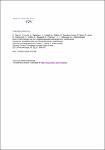Neue Empfehlungen für die Umgebungsuntersuchungen bei Tuberkulose
Diel, Roland
Loytved, Gunther
Nienhaus, Albert
Castell, S.
Detjen, A.
Geerdes-Fenge, H.
Haas, Walter
Hauer, Barbara
Königstein, B.
Maffei, D.
Magdorf, Klaus
Priwitzer, M.
Zellweger, J.-P.
Loddenkemper, Robert
Nach der Einführung der neuen Interferon-γ-Release Assays (IGRAs) in den Empfehlungen des Deutschen Zentralkomitees zur Bekämpfung der Tuberkulose im Jahre 2007 hat sich die Datenlage für deren Einsatz beträchtlich verbessert. Da Sensitivität und Spezifität von IGRAs bei Erwachsenen in zumindest teilweise BCG-geimpften Kollektiven derjenigen des Tuberkulin-Hauttests (THT) im Allgemeinen überlegen sind, wird bei Kontaktpersonen im Gegensatz zum früheren Zweistufenverfahren nur noch der primäre Einsatz von IGRAs empfohlen. Aufgrund fehlender Evidenz über die Zuverlässigkeit von IGRAs bei Kindern unter 5 Jahren bleibt der THT in dieser Altersgruppe Mittel der Wahl; bei älteren Kindern können beide Tests angewendet werden. Die neuen Empfehlungen unterstreichen die Notwendigkeit einer sorgfältigen Vorauswahl enger Kontaktpersonen, damit positive Testbefunde mit hoher Wahrscheinlichkeit auch eine frische Infektion widerspiegeln und so den Nutzen einer Chemoprävention erhöhen. Das Nachtesten von positiv getesten Kontaktpersonen kann zu einer beträchtlichen Anzahl falsch-negativer Resultate führen und sollte bei dokumentierter Exposition daher unterbleiben. In 2007, the German Central Committee against Tuberculosis (DZK) published recommendations for contact tracing that introduced the new interferon gamma release assays (IGRAs). Meanwhile, substantial progress has been made in documenting the utility of IGRAs. Because IGRAs are usually superior to the tuberculin skin test (TST) in detecting latent TB infection (LTBI) with respect to sensitivity and specificity in adult contact populations that are at least partially BCG vaccinated, it is now recommended that instead of two-step testing only IGRAs be used.[nl]As the literature does not yet provide sufficient data on the accuracy of IGRAs in children younger than 5 years, the TST remains the method of choice in that age group. To date, also, no clear body of data exists to substantiate better performance for IGRAs than for the TST in older children, thus in this age group using of either test is recommended. The new recommendations also underscore the importance of a diligent preselection of close contacts in order to achieve a high probability that positive test results represent recent infection and to thus increase the benefit of chemopreventive treatment for those identified as requiring it. In a third point of update, it is noted that re-testing of contacts individuals found positive for LTBI may produce a considerable number of false-negative results and should thus be avoided in case of documented exposure.
No license information

